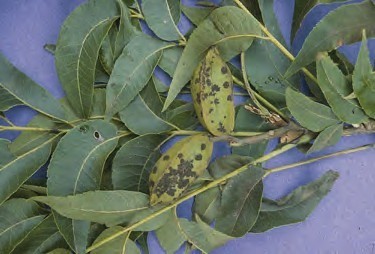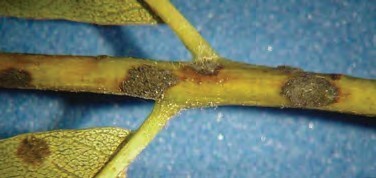Scab - Pecan Disease
Searcy, Ark. –
Pecan trees are widely grown in Arkansas for both shade and nuts. There are several important disease problems that can affect both the shade value and the nut crop. Pecan Scab, caused by the fungus Cladosporium caryigenum, is the most widespread disease of pecans. It also affects hickory trees. Even though scab can occur on leaves and twigs, the main damage is caused by infection of the nut shuck (husk). Infected nuts fall prematurely or fail to reach full size. Repeated infections also weaken the tree.
Scab damage depends on weather conditions and variety of pecan tree. Frequent rainfall and extended periods of wetness and dew on leaves and nuts are critical for infection and disease development. The scab fungus forms small, circular, olive green to black sunken spots or blotches on leaves, nut shucks (husks), leaf blades and leaf petioles. Figures 1 and 2.

Figure 1. Pecan scab on nuts

Figure 2: Close up of scab lesions on leaf tissue.
Leaf spots may become numerous, leading to premature leaf drop, and may lead to infection of the nuts. As spots on the nut shuck grow together, entire nuts may become blackened. Other fungi such as pink mold quickly colonize the damaged nuts causing additional decay. Scab infections of the shucks may also produce “Stick tights,” a condition in which the shuck does not separate from the nuts during harvest.
Management
The most practical long-term management practice for controlling scab is to plant varieties that have resistance.
Cultivars with excellent scab resistance (According to UGA research):
- Kanza
- Elliott
- Gafford
- Jenkins
- McMillan
- Carter
- Syrup Mill
Cultivars with good scab resistance (According to UGA research):
- Sumner (although it an increased susceptibility to black aphids)
Cultivars with mediocre scab resistance (According to UGA research):
- Oconee
- Caddo
- Forkert
It’s important to note that the scab fungus can change over time and adapt to resistant varieties. Therefore this practice is not foolproof, so preventative fungicide applications may become necessary for control of scab. While commercial pecan growers have the equipment and fungicides to make their use practical, this is not the case for homeowners with only a few trees. Because good spray coverage is required and trees may be very large, only special spray equipment can be used. Growers should consult Extension publication MP154, Arkansas Plant Disease Control Products Guide, for a list of fungicides.
Before hiring a commercial sprayer to treat pecans, homeowners should try good sanitation practices. That is, you should remove and destroy all fallen leaves, shucks and nuts each winter or in the early spring before buds begin to swell. These fallen leaves and nuts can be primary sources for new infections in the spring. Removing damaged twigs and limbs by selective pruning should also be practiced during the dormant season, if possible.
Pecan trees should be fertilized according to a recent soil test and watered well, especially during hot, dry weather conditions. Low fertility can make trees more susceptible to diseases and reduce growth and fruit set.
By Sherri Sanders
County Extension Agent - Agriculture
The Cooperative Extension Service
U of A System Division of Agriculture
Media Contact: Sherri Sanders
County Extension Agent - Agriculture
U of A Division of Agriculture
Cooperative Extension Service
2400 Old Searcy Landing Road Searcy AR 72143
(501) 268-5394
ssanders@uada.edu
The Arkansas Cooperative Extension Service is an equal opportunity institution. If
you require a reasonable accommodation to participate or need materials in another
format, please contact your County Extension office (or other appropriate office)
as soon as possible. Dial 711 for Arkansas Relay.
Pursuant to 7 CFR § 15.3, the University of Arkansas System Division of Agriculture
offers all its Extension and Research programs and services (including employment)
without regard to race, color, sex, national origin, religion, age, disability, marital
or veteran status, genetic information, sexual preference, pregnancy or any other
legally protected status, and is an equal opportunity institution.